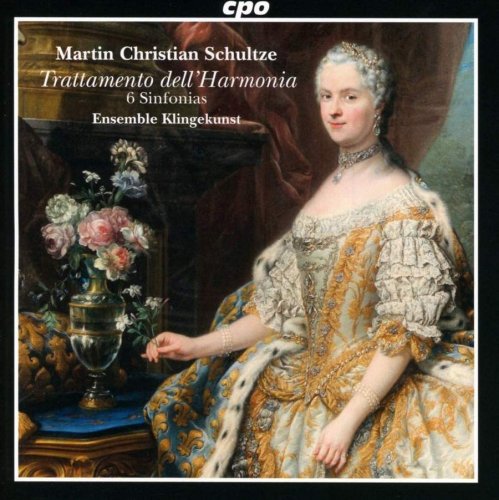Ensemble Klingekunst - Schultze: Trattamento dell’Harmonia - 6 Sinfonias (2020)

Artist: Ensemble Klingekunst
Title: Schultze: Trattamento dell’Harmonia - 6 Sinfonias
Year Of Release: 2020
Label: cpo
Genre: Classical
Quality: FLAC (tracks+.cue, artwork)
Total Time: 01:10:22
Total Size: 383 MB
WebSite: Album Preview
Tracklist:Title: Schultze: Trattamento dell’Harmonia - 6 Sinfonias
Year Of Release: 2020
Label: cpo
Genre: Classical
Quality: FLAC (tracks+.cue, artwork)
Total Time: 01:10:22
Total Size: 383 MB
WebSite: Album Preview
1. Sinfonia I in D-Dur - 1. Allegro (3:39)
2. Sinfonia I in D-Dur - 2. Largo Andante (2:00)
3. Sinfonia I in D-Dur - 3. Allegro (3:27)
4. Sinfonia II in G-Dur - 1. Allegro (5:32)
5. Sinfonia II in G-Dur - 2. Adagio con affecto (2:11)
6. Sinfonia II in G-Dur - 3. Allegro amoroso (4:03)
7. Sinfonia III in D-Dur - 1. Largo (3:05)
8. Sinfonia III in D-Dur - 2. Allegro (3:22)
9. Sinfonia III in D-Dur - 3. Aria paysana (3:22)
10. Sinfonia III in D-Dur - 4. Vivace (3:21)
11. Sinfonia IV in F-Dur - 1. Adagio (2:38)
12. Sinfonia IV in F-Dur - 2. Allegro moderato (4:15)
13. Sinfonia IV in F-Dur - 3. Largo (0:59)
14. Sinfonia IV in F-Dur - 4. Allegro (3:34)
15. Sinfonia V in G-Dur - 1. Pastorale Largo (2:52)
16. Sinfonia V in G-Dur - 2. Allegro (3:33)
17. Sinfonia V in G-Dur - 3. Largo (1:02)
18. Sinfonia V in G-Dur - 4. Menuetto 1.mo, 2.do (4:28)
19. Sinfonia V in G-Dur - 5. Polonnoiza 1.ma, 2.da (4:16)
20. Sinfonia VI in c-moll - 1. Adagio (2:35)
21. Sinfonia VI in c-moll - 2. Allemanda Allegro (3:16)
22. Sinfonia VI in c-moll - 3. Largo (1:26)
23. Sinfonia VI in c-moll - 4. Alla breve (1:36)
Hardly any biographical information about the composer Martin Christian Schultze has been handed down to us. On the cover of the Trattamento dellharmonia, which was engraved and published in Paris in 1773, we find his name with the initials 'M.C.' and 'D.B.' ('M.C. Schultze D.B.'), which according to the RISM signifies 'Martin Christian Schultze from Berlin.' The six symphonies contained in this collection may be understood as harmonic treatises. They have been written very much in the Italian style, and in them we find very many polyrhythmic elements running through all the movements for example, frequent triplets against sixteenths. In addition, at the time Schultze must have had an outstanding gambist by his side who was able to render this extremely demanding gamba part. The violin part with many double stops and virtuosic passages likewise presupposes some talent. By contrast, the flute part more probably would have been written for an amateur. Here these pieces are interpreted by the Klingekunst Ensemble, whose members base their work on well-founded occupation with historical performance practice but also always assign foremost importance to vibrant musical communication.
Download Link Isra.Cloud
Schultze - Trattamento dell'Harmonia - Ens. Klingekunst.rar - 383.1 MB
Schultze - Trattamento dell'Harmonia - Ens. Klingekunst.rar - 383.1 MB




![Johnny Janis - Playboy Presents... Once In a Blue Moon (2015) [Hi-Res] Johnny Janis - Playboy Presents... Once In a Blue Moon (2015) [Hi-Res]](https://img.israbox.com/img/2025-12/29/hpechfkz7kpvyn01p0qdae2u4.jpg)



![Turma da Gafieira - Samba Em Hi-Fi (2022) [Hi-Res] Turma da Gafieira - Samba Em Hi-Fi (2022) [Hi-Res]](https://img.israbox.com/img/2025-12/25/uoi60ek915jn9jylif45ufqxd.jpg)